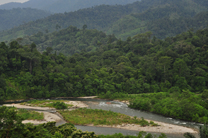Impacts of Conversion and Drainage of Tropical Peat Forests on Carbon Fluxes to Atmosphere and Water
 Indonesia has the largest tropical peat forests, ranging from 18 to 27 million hectares (45 to 67 million acres). It has been estimated that 44-67% of these peat forests have been disturbed and substantially drained in order to lower the water table to depths which are suitable for agricultural uses, including rice cultivation, industrial pulp production, and recently oil palm plantations. The drainage and conversion of peatlands lead to increased rates of peatland subsidence, and potentially act as an important source of carbon dioxide emissions. At the same time, the impacts of peatland drainage and land cover change of peat forests into mono-crop plantations of oil palms have barely been investigated. This project examines how open peatlands, forested peatlands, and oil palm plantations differ in their ability to act as sources or sinks of carbon as they interact with the atmosphere, and what factors control the accumulation and decomposition of peat under these different land cover systems.
Indonesia has the largest tropical peat forests, ranging from 18 to 27 million hectares (45 to 67 million acres). It has been estimated that 44-67% of these peat forests have been disturbed and substantially drained in order to lower the water table to depths which are suitable for agricultural uses, including rice cultivation, industrial pulp production, and recently oil palm plantations. The drainage and conversion of peatlands lead to increased rates of peatland subsidence, and potentially act as an important source of carbon dioxide emissions. At the same time, the impacts of peatland drainage and land cover change of peat forests into mono-crop plantations of oil palms have barely been investigated. This project examines how open peatlands, forested peatlands, and oil palm plantations differ in their ability to act as sources or sinks of carbon as they interact with the atmosphere, and what factors control the accumulation and decomposition of peat under these different land cover systems.
For more information or to join this internship please contact Dr Walter Oechel
